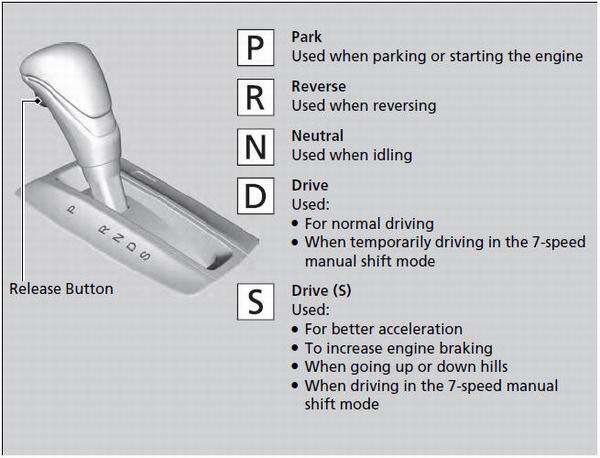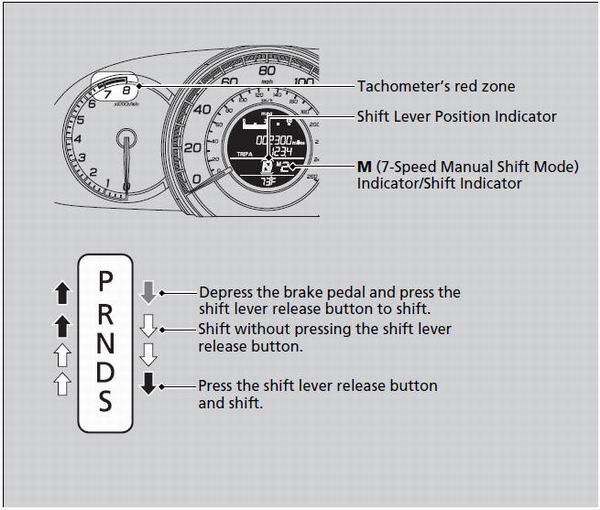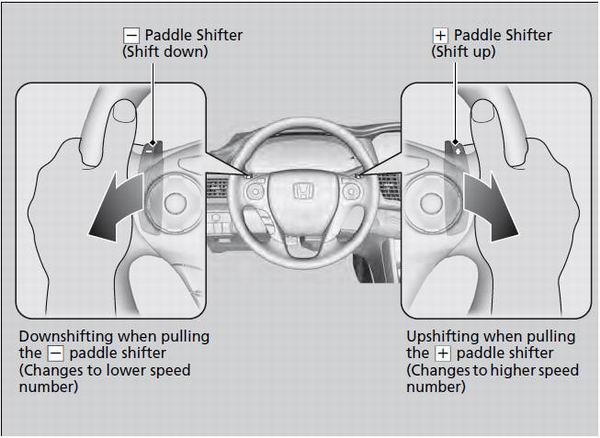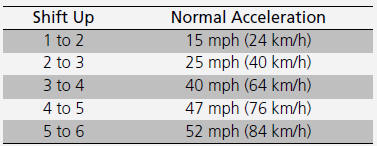 Honda Accord: Shifting
Honda Accord: Shifting
Change the shift position in accordance with your driving needs.
• Shift lever positions

You cannot turn the ignition switch to LOCK
 and remove the key unless the shift lever is in
and remove the key unless the shift lever is in
 .
.
The vehicle may move forward very slightly even in
 while the engine is cold.
while the engine is cold.
Depress the brake pedal firmly and, when necessary, apply the parking brake.
When shifting positions in extremely low temperatures (-22°F/-30°C), there may be a short delay before the shift position is displayed. Always confirm you are in the correct shift position before driving.
• Shift Lever Operation

NOTICE
When you change the shift lever from
 to
to
 and
vice versa, come to a complete stop and keep the
brake pedal depressed.
and
vice versa, come to a complete stop and keep the
brake pedal depressed.
Operating the shift lever before the vehicle has come to a complete standstill can damage the transmission.
Use the shift lever position indicator to check the lever position before pulling away.
If the transmission indicator blinks when driving, in any shift position, there is a problem with the transmission.
Avoid sudden acceleration and have the transmission checked by a dealer as soon as possible.
The fuel supply may be cut off if you drive at engine speeds in or over the tachometer's red zone (engine speed limit). If this happens, you may experience a slight jolt.
It may not be possible to operate the shift lever if the brake pedal is applied while the shift lever release button is held down.
Depress the brake pedal first.
• 7-Speed Manual Shift Mode
Use the paddle shifters to change between 1st and 7th speeds without removing your hands from the steering wheel. The transmission switches to the 7-speed manual shift mode when you pull a paddle shifter while driving. This mode is useful when engine braking is needed.
• When the shift lever is in  :
:
The shift mode goes into the 7-speed manual shift mode temporarily, and the number is displayed in the shift indicator.
The 7-speed manual shift mode is canceled automatically if you drive at constant speed or accelerate, and the number in the shift indicator goes off.
You can cancel this mode by pulling the (+ paddle shifter for a few seconds.
The 7-speed manual shift mode is especially useful when reducing the vehicle speed temporarily before making a turn.
• When the shift lever is in (S:
The shift mode goes into the 7-speed manual shift mode. The M indicator and the speed number are displayed in the shift indicator. As the vehicle speed slows down, the transmission automatically shifts down accordingly. When the vehicle comes to a stop, it automatically shifts down into 1st.
If the vehicle speed increases and the engine speed reaches near the tachometer’s red zone, the transmission automatically shifts up.
You can only pull away in 1st speed.
When canceling the 7-speed manual shift mode, move the shift lever from
 to
to
 . When the 7-speed manual shift mode
is canceled, the M indicator and shift
indicator go off.
. When the 7-speed manual shift mode
is canceled, the M indicator and shift
indicator go off.
To improve fuel economy, the transmission may shift up to a higher speed than the seventh under certain circumstances. In this case, the number in the shift indicator remains as 7.
In the 7-speed manual shift mode, the transmission shifts up or down by operating either paddle shifter under the following conditions: Shift Up: The engine speed reaches the lowest threshold of the higher speed position.
Shift Down: The engine speed reaches the highest threshold of the lower speed position.
When the engine speed reaches near the tachometer’s red zone, the transmission shifts up automatically.
When the engine speed reaches the lowest threshold of the selected speed position, the transmission shifts down automatically.
Operating the paddle shifters on slippery surfaces may cause the tires to lock up. In this case, the 7- speed manual shift mode is canceled and goes back to the normal D driving mode.
7-Speed Manual Shift Mode Operation

Each paddle shift operation makes a single speed change.
To change continuously, release the paddle shifter before pulling it again for the next speed.
Recommended Shift Points
Use this table as a guideline for efficient fuel economy and effective emission control.

The shift indicator blinks when you cannot shift up or down. It indicates that your vehicle speed is not in its allowable shifting range.
Slightly accelerate to shift up and decelerate to shift down while the indicator is blinking.

 Shifting
Shifting
Change the shift position in accordance with your driving needs.
• Shift lever positions
You cannot turn the ignition switch to LOCK
and remove the key unless the shift lever is in
.
The ...
 Shifting
Shifting
Change the shift position in accordance with your driving needs.
• Shift lever positions
You cannot change the power mode from ON to
VEHICLE OFF (LOCK) unless the shift lever is in (P.
The ve ...
See also:
Front Seat Lumbar Support
Replacement
2-door Driver's Seat
SRS components are located In this area. Review the
SRS component locations (see page 24-23) and the
precautions and procedures (see page 24-25) before
doing repairs or servic ...
General Troubleshooting
Information
Lever-Locked Connector
Disconnecting
To disconnect the connector, pull the lever (A) while
pushing the lock tab (B) down, then pull the connector
(C).
Connecting
To connect the connector, push ...
Transmission Reassembly
NOTE: Prior to reassembly, clean all the parts in solvent,
dry them, and apply MTF to any contact surfaces.
1. Install the magnet (A) and the differential assembly
(B).
NOTE: Clean the magnet ...
